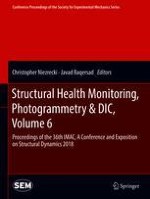2019 | Book
Structural Health Monitoring, Photogrammetry & DIC, Volume 6
Proceedings of the 36th IMAC, A Conference and Exposition on Structural Dynamics 2018
Editors: Christopher Niezrecki, Javad Baqersad
Publisher: Springer International Publishing
Book Series : Conference Proceedings of the Society for Experimental Mechanics Series
